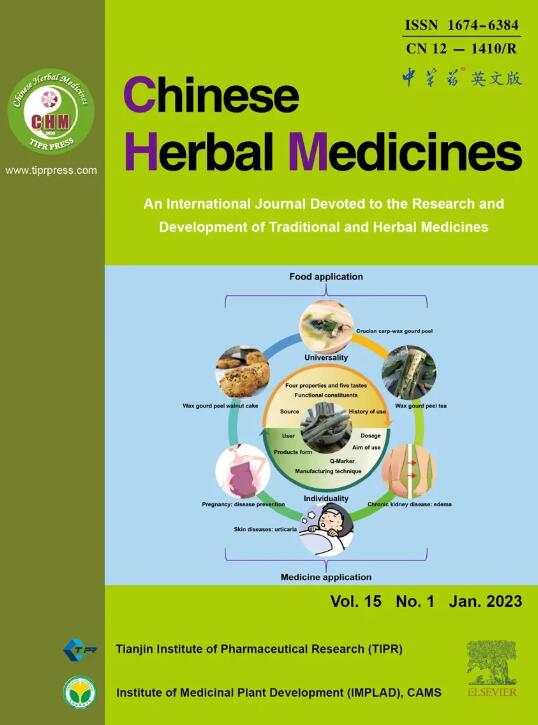Osthole 通过抑制 IL-31 的产生,改善 2,4-二氯硝基苯诱发的特应性皮炎的慢性瘙痒症状
IF 8.9
4区 医学
Q1 CHEMISTRY, MEDICINAL
引用次数: 0
摘要
目的探讨蛇床子素治疗特应性皮炎(AD)的治疗潜力,重点探讨其缓解慢性瘙痒(CP)的能力及其分子机制。方法研究蛇蛇素对2,4-二氯硝基苯(DNCB)诱导的AD小鼠模型和肿瘤坏死因子-α (TNF-α)和干扰素-γ (IFN-γ)刺激的人永生化表皮(HaCaT)细胞的抗炎作用。在AD小鼠模型中特异性评价蛇床子的止痒作用。采用苏木精和伊红(HE)染色、酶联免疫吸附试验(ELISA)、免疫印迹(WB)、实时荧光定量PCR (qRT-PCR)和免疫荧光染色等方法。结果sosthole改善了ad样小鼠的皮肤损伤和临床皮炎评分,减少了抓伤次数,降低了表皮厚度。它还降低了皮肤组织和HaCaT细胞中白细胞介素(IL)-31和IL-31受体A (IL-31 RA)的水平。此外,蛇床子素抑制磷酸化p65 (p-p65)和磷酸化核因子κ b α (p- κ b α)的蛋白表达水平。同时提高HaCaT细胞过氧化物酶体增殖物激活受体α (PPARα)和PPARγ的蛋白表达水平。结论蛇床子素通过激活PPARα、PPARγ,抑制NF-κB信号通路,抑制IL-31、IL-31 RA的表达,有效抑制AD CP。本文章由计算机程序翻译,如有差异,请以英文原文为准。
Osthole ameliorates chronic pruritus in 2,4-dichloronitrobenzene-induced atopic dermatitis by inhibiting IL-31 production
Objective
This study aims to elucidate the therapeutic potential of osthole for the treatment of atopic dermatitis (AD), focusing on its ability to alleviate chronic pruritus (CP) and the underlying molecular mechanisms.
Methods
In this study, we investigated the anti-inflammatory effects of osthole in both a 2,4-dichloronitrobenzene (DNCB)-induced AD mouse model and tumor necrosis factor-α (TNF-α) and interferon-γ (IFN-γ) stimulated huma immortalized epidermal (HaCaT) cells. The anti-itch effect of osthole was specifically assessed in the AD mouse model. Using methods such as hematoxylin and eosin (HE) staining, enzyme-linked immunosorbent assay (ELISA), western blot (WB), quantitative real-time PCR (qRT-PCR), and immunofluorescence staining.
Results
Osthole improved skin damage and clinical dermatitis scores, reduced scratching bouts, and decreased epidermal thickness AD-like mice. It also reduced the levels of interleukin (IL)-31 and IL-31 receptor A (IL-31 RA) in both skin tissues and HaCaT cells. Furthermore, Osthole suppressed the protein expression levels of phosphor-p65 (p-p65) and phosphor-inhibitor of nuclear factor kappa-Bα (p-IκBα). Meanwhile, it increased the protein expression levels of peroxisome proliferator-activated receptor α (PPARα) and PPARγ in HaCaT cells.
Conclusion
These findings indicated that osthole effectively inhibited CP in AD by activating PPARα, PPARγ, repressing the NF-κB signaling pathway, as well as the expression of IL-31 and IL-31 RA.
求助全文
通过发布文献求助,成功后即可免费获取论文全文。
去求助
来源期刊

Chinese Herbal Medicines
CHEMISTRY, MEDICINAL-
CiteScore
4.40
自引率
5.30%
发文量
629
审稿时长
10 weeks
期刊介绍:
Chinese Herbal Medicines is intended to disseminate the latest developments and research progress in traditional and herbal medical sciences to researchers, practitioners, academics and administrators worldwide in the field of traditional and herbal medicines. The journal's international coverage ensures that research and progress from all regions of the world are widely included.
CHM is a core journal of Chinese science and technology. The journal entered into the ESCI database in 2017, and then was included in PMC, Scopus and other important international search systems. In 2019, CHM was successfully selected for the “China Science and Technology Journal Excellence Action Plan” project, which has markedly improved its international influence and industry popularity. CHM obtained the first impact factor of 3.8 in Journal Citation Reports (JCR) in 2023.
 求助内容:
求助内容: 应助结果提醒方式:
应助结果提醒方式:


